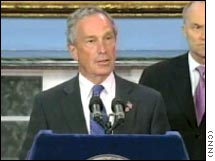 |
| New York City Mayor Michael Bloomberg says there will be 'no winners' if city transit workers strike. |
|
|
|
NEW YORK (CNN) -
If New York City bus and subway workers strike when their contract expires at 12:01 a.m. ET Friday, there will be "no winners," Mayor Michael Bloomberg said as he described the contingency plan to deal with a possible mass transit shutdown.
"Let me be clear about the impact of the strike, it would do far worse than inconvenience the 8.1 million city residents and nearly one million suburban commuters. Emergency vehicles may get stuck in traffic, and people will have difficulty getting to hospitals," Bloomberg said Wednesday.
Negotiators for the Metropolitan Transit Authority and the Transport Workers Union Local 100 had yet to begin contract talks Thursday morning, as officials from both sides began the day by discussing what MTA spokesman Tom Kelly called "departmental issues."
Members of the union and the MTA have been deadlocked in negotiations for several days. The TWU has threatened to strike when their contract expires at midnight Thursday if their demands are not met.
"There are too many issues on the table for the last day," Kelly said.
When asked if there was any reason for optimism, Kelly responded, "There's no reason for pessimism. That's the way collective bargaining works."
Strike costs
Economic losses will add to the inconveniences and frustrations, Bloomberg said.
"Our economy would lose about $400 million per day and would particularly hurt the working families who can least afford it, including thousands who work in the tourism and hospitality industries," Bloomberg said. The city government would lose $22 million a day in tax revenue and overtime police expenditures.
In court papers filed Monday it was estimated that a transit strike would have a devastating effect on the city, costing $440 million to $600 million a day in lost business activity.
Overtime for police officers called in during a strike would add another $10 million a day, the court motion said.
At the time of the last transit strike, in 1980, some 4.8 million people used the city's buses and subways each day. Now, that figure has grown to 7.5 million, according to the city.
On Tuesday, the city sued the TWU for damages it will incur if the strike takes place.
The New York State Supreme Court granted an injunction Tuesday prohibiting transit workers from striking, arguing that a mass transit shutdown would cause irreparable harm to the city.
State Supreme Court Judge Theodore Jones issued the ruling after a hearing in which an attorney representing New York state argued that a strike of more than 33,000 transit workers would cripple the city.
A lawyer for the Transport Workers Union argued against the injunction.
Wall Street prepares
Anticipating a strike, New York City's financial community has also created a contingency plan of its own to keep Wall Street open for business.
According to the Wall Street Journal, Wall Street has devised plans so that it can come out unharmed if a strike shuts down New York City's public-transportation system.
Financial institutions citywide will encourage more employees to telecommute, travel in carpools or, in some cases, ride in buses and vans that the companies are providing.
The Journal report said that the most extensive effort to get people to their jobs is being orchestrated by the Securities Industry Association. The Wall Street trade group has hired a fleet of 50 private coach buses that will ferry critical employees to their offices in midtown and downtown Manhattan.
Seventeen firms, including the New York Stock Exchange, have signed up to participate, the report said.
Bloomberg's plan
In an effort to reduce danger and inconvenience in case of a strike, the city will order higher vehicle occupancy (HOV), some street closures, and the creation of carpool staging areas, additional Staten Island ferry service and capped cab fares.
At least four people per vehicle will be required for those entering the city from south of 96th Street and on most Manhattan bridges and tunnel crossings during the 5 a.m. to 11 a.m. weekday rush hours.
Several key streets in Manhattan will be closed to general traffic: Fifth and Madison avenues from 23rd to 96th streets; 26th, 29th, 49th and 50th streets from First to 12th avenues; and part of Church Street.
Only emergency vehicles, school, express and charter buses, access-a-ride, ambulances and full commuter vans will be able to use those streets from 5 a.m. and 8 p.m. on weekdays.
More than 40 carpool staging areas will be set up in the five boroughs where incoming commuters can pick up extra passengers to meet the HOV requirement.
"If you do not have enough people to qualify and you want to drive into Manhattan... go to one of these locations and you'll be able to find other people who will appreciate the ride in," said Bloomberg.
Taxis will be allowed to pick up multiple passengers and will operate on a modified fare schedule that prevents fares within designated zones from exceeding $10 per passenger.
Staten Island Ferry service will be expanded and all nonemergency road work will be suspended. Public schools will operate on a two-hour delay.
Bloomberg urged city residents and commuters to have individual contingency plans in place by Thursday night, telling them to "be inventive" and "make do with the hand we hope we won't be dealt."
He suggested telecommuting, walking, biking and staying with friends in the city.
A complete description of New York City's contingency plan can be found at www.nyc.gov.
-- Reporting by Allen Chernoff, CNN Correspondent and Stacey Delikat, CNN News Assistant
---------------------
Click here for business headline news.

|